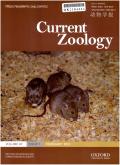Long-term effect of inbreeding in the yellow steppe lemming (Eolagurus luteus) captive colony
IF 2
2区 生物学
Q2 ZOOLOGY
引用次数: 0
Abstract
In the current research, we investigated the impact of gradually increasing inbreeding on the life span and reproductive rate of yellow steppe lemmings (Eolagurus luteus) that reproduced in the Moscow Zoo. The focal captive colony existed during 2017–2021. The studied animals belonged to the second–tenth generations. The founders of the colony were five females and five males originated from three females and four males live-trapped in the Zaisan basin (Kazakhstan). The degree of their descendant relatedness progressively increased. The animals intended to be used for reproduction were distributed to the pairs with unfamiliar partners. We constructed the pedigree of 177 individuals and calculated their inbreeding coefficients. This parameter varied from 0 to 0.29, the maximum values were registered in the lemmings of seventh–tenth generations. We measured the life span of 61 individuals and used information about the reproduction or its absence in 45 pairs. A substantial decline in the individual life span and reproductive parameters in the breeding pairs with a progressive increase of the inbreeding coefficients was registered. The number of delivered litters, born pups, and young lived up to the age of puberty significantly depended on the level of mother inbreeding. The noticeable traits of inbreeding depression in the colony appeared in 2019–2020, when the offspring inbreeding coefficients reached approximately 0.2. Therefore, we assume that if the E. luteus population originates from a relatively small number of non-inbred and unfamiliar individuals, then the successful reproduction without significant inbreeding depression will continue for several generations of offspring.黄草原旅鼠圈养群近亲繁殖的长期影响
在当前的研究中,我们调查了近亲繁殖逐渐增加对在莫斯科动物园繁殖的黄色草原旅鼠(Eolagurus luteus)的寿命和繁殖率的影响。重点圈养群存在于2017-2021年期间。所研究的动物属于第二代至第十代。群落的创建者是五只雌性和五只雄性,它们分别来自在柴桑盆地(哈萨克斯坦)活体诱捕的三只雌性和四只雄性。它们的后代亲缘关系逐渐增强。打算用于繁殖的动物被分配给了不熟悉的伙伴。我们构建了 177 个个体的血统,并计算了它们的近亲繁殖系数。这个参数在0到0.29之间变化,最大值出现在第七代到第十代的旅鼠身上。我们测量了61只个体的寿命,并使用了45对个体的繁殖或不繁殖信息。结果表明,随着近亲繁殖系数的逐渐增加,繁殖对的个体寿命和繁殖参数大幅下降。产仔数、出生幼崽数和活到青春期的幼崽数明显取决于母亲的近亲繁殖水平。种群近交抑郁的明显特征出现在 2019-2020 年,当时后代近交系数达到约 0.2。因此,我们假定,如果黄体伊蚊种群起源于数量相对较少的非近亲繁殖和陌生个体,那么成功繁殖而无明显近亲繁殖抑制的情况将持续数代后代。
本文章由计算机程序翻译,如有差异,请以英文原文为准。
求助全文
约1分钟内获得全文
求助全文
来源期刊

Current Zoology
Agricultural and Biological Sciences-Animal Science and Zoology
CiteScore
3.20
自引率
9.10%
发文量
111
审稿时长
6 weeks
期刊介绍:
About the Journal
Current Zoology (formerly Acta Zoologica Sinica, founded in 1935) is an open access, bimonthly, peer-reviewed international journal of zoology. It publishes review articles and research papers in the fields of ecology, evolution and behaviour.
Current Zoology is sponsored by Institute of Zoology, Chinese Academy of Sciences, along with the China Zoological Society.
 求助内容:
求助内容: 应助结果提醒方式:
应助结果提醒方式:


